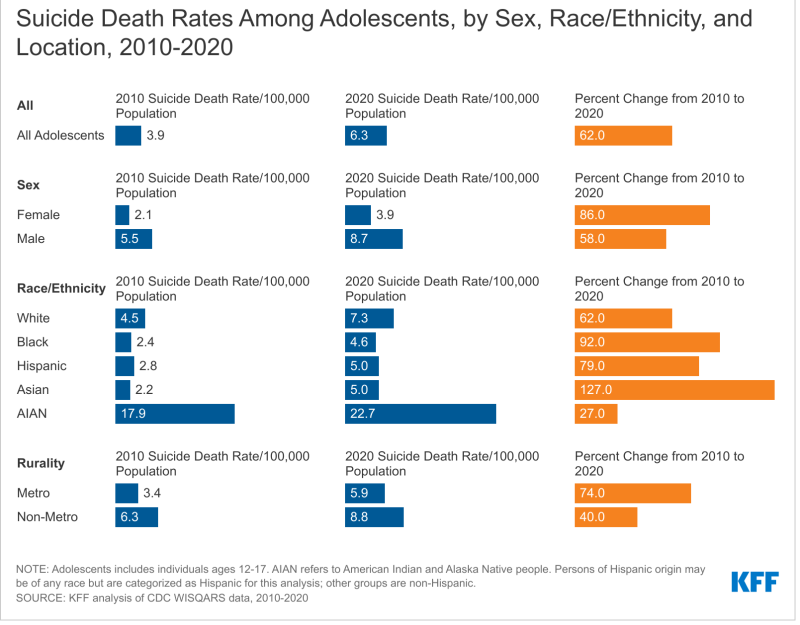Mental health takes up more and more of the conversation these days as COVID-19 underscored a problem that had been increasing even before the pandemic. A recent study in Pediatrics illustrates that’s the case even for children. Or, perhaps, especially for children. The study looks at youngsters sent to emergency departments (EDs) in Illinois because of suicidal ideation (SI).
“We show that there was a continuous increase in emergency department visits coded for suicidal ideation for youth in Illinois, with a spike in visits in 2019 before the coronavirus disease 2019 pandemic and a subsequent surge in hospitalizations through 2021,” the study states.
Between January 2016 and June 2021, 81,051 youngsters ages 5 to 19 were admitted to EDs in the state for SI, and about 23.3% of those patients were hospitalized. Although such admissions had been increasing before COVID-19, the pandemic seems to have exacerbated the problem.
“Although there was a modest increasing trend from 2016 to 2018, there was a very sharp spike in fall 2019, followed by a similar spike during the pandemic fall of 2020, with highest number of monthly visits during October 2020,” the study states. “Youth aged 14 to 17 years had the highest frequency of SI ED monthly visits, with visits in this group greater than the other age groups combined.”
ED visits for suicidal thoughts increased 59% from 2016-17 to 2019-21. Cases in which SI had been the principal reason for ED visits rose from 34.6% to 44.3% in the same period.
Corresponding author Audrey Brewer, M.D., an instructor at Northwestern University Feinberg School of Medicine and a pediatrician at the Ann & Robert H. Lurie Children’s Hospital of Chicago, said in a press release that “suicidal ideation can be thought about as two types: actively thinking about suicide or having thoughts, but not having a plan. That could be the difference in why someone might get admitted to the hospital.”
The data were mined from a review of ED visits involving SI from 205 Illinois hospitals—SI meaning that they considered harming themselves but did not actually go through with an attempt.
Suicide is the second leading cause of death among individuals between the ages of 10 and 14 and the third leading cause of death among individuals between the ages of 15 and 24, according to the Centers for Disease Control and Prevention. It increased over 45% between 1999 and 2020, as more than 47,000 individuals ages 10 to 19 committed suicide.
Brewer said, “a lot of people have talked about mental health problems in youth during the pandemic, but it was happening before the pandemic. This has been an issue for so long, and it’s getting worse.”
The study does not delve into why children and adolescents had suicidal thoughts, though the press release said it could be a combination of factors such as school-related stress, social isolation, social media exposure, family adversity, neglect or abuse.
Senior author Joe Feinglass, Ph.D., said, “this is like smoke. And there’s definitely a fire, but we don’t yet know and are not yet addressing what is causing the fire.”
Other institutions and society in general (see the chart below) also seem to be seeing the smoke.

Last month, the U.S. Preventive Services Task Force (USPSTF) issued new guidelines saying that all children ages 8 to 18 should be screened for anxiety. The task force did not recommend that children under 7 also be screened. “The USPSTF concludes with moderate certainty that screening for anxiety in children and adolescents aged 8 to 18 years has a moderate net benefit,” the recommendation said. “The USPSTF concludes that the evidence is insufficient on screening for anxiety in children 7 years or younger.”
Also last month, the United Health Foundation, the philanthropic arm of UnitedHealth Group, issued a report that found:
- Anxiety increased 23% among children ages 3 to 17 between 2017 and 2018 and between 2020 and 2021. Between 2020 and 2021, anxiety affected roughly 5.6 million children ages 3 to 17—an increase of more than 1 million children since 2017-18.
- Depression increased 27% among children ages 3 to 17 between 2017 and 2018 and between 2020 and 2021. In 2020-21, depression affected roughly 2.5 million children ages 3 to 17, an increase of more than a half a million than in 2017-18.
- The teen suicide rate increased 29% at the national level between 2012 and 2014 and between 2018 and 2020 among 15- to 19-year-olds.
Although the study in Pediatrics focused on Illinois data, authors said the diverse demographics of Illinois’ population reflect the general population of the U.S.